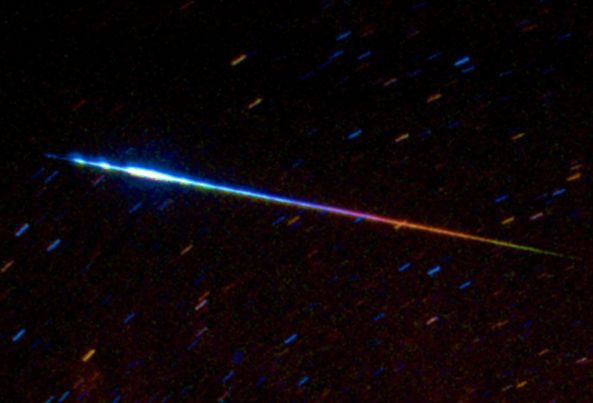Credit & Copyright: S. Kohle & B. Koch,
Bonn University
Explanation:
The ongoing
Perseid
Meteor Shower should be at its strongest on August 12 and 13.
The best time to watch will be between 2:00 AM and dawn on Monday
morning (so plan on setting your alarm tonight!)
and then again on Tuesday.
In dark, moonless, predawn
skies you may see dozens of meteors per hour.
Grains of cosmic sand and gravel shed from
Comet Swift-Tuttle will
streak across the sky as they vaporize during entry into Earth's
atmosphere.
Tracing the meteor
trails backwards,
experienced skygazers will find they converge
on the constellation Perseus, thus this
annual meteor shower's name.
Pictured
above is a Perseid meteor from 1993.
The colors are representative but digitally enhanced.
As the
meteor streaked across the night sky,
different excited atoms emitted different colors of light.
The origin of the green tinge visible at the right is currently unknown,
however, and might result from
oxygen
in Earth's atmosphere.
1999 2000 2001 2002 2003 2004 2005 2006 2007 2008 2009 2010 2011 2012 2013 2014 2015 2016 2017 2018 2019 2020 2021 2022 2023 2024 2025 |
Yanvar' Fevral' Mart Aprel' Mai Iyun' Iyul' Avgust Sentyabr' Oktyabr' Noyabr' Dekabr' |
NASA Web Site Statements, Warnings, and Disclaimers
NASA Official: Jay Norris. Specific rights apply.
A service of: LHEA at NASA / GSFC
& Michigan Tech. U.
|
Publikacii s klyuchevymi slovami:
meteor - Perseids - Meteor - Perseidy
Publikacii so slovami: meteor - Perseids - Meteor - Perseidy | |
Sm. takzhe:
Vse publikacii na tu zhe temu >> | |
